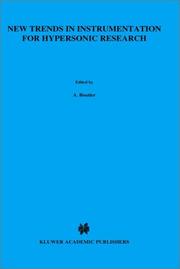| Listing 1 - 10 of 43 | << page >> |
Sort by
|
Book
Year: 1962 Publisher: New York : Academic Press,
Abstract | Keywords | Export | Availability | Bookmark
 Loading...
Loading...Choose an application
- Reference Manager
- EndNote
- RefWorks (Direct export to RefWorks)
Book
Year: 2000 Publisher: Edwards, California : National Aeronautics and Space Administration, Dryden Flight Reserch Center,
Abstract | Keywords | Export | Availability | Bookmark
 Loading...
Loading...Choose an application
- Reference Manager
- EndNote
- RefWorks (Direct export to RefWorks)
Book
Year: 1969 Publisher: Washington, D.C. : National Aeronautics and Space Administration,
Abstract | Keywords | Export | Availability | Bookmark
 Loading...
Loading...Choose an application
- Reference Manager
- EndNote
- RefWorks (Direct export to RefWorks)
Book
ISBN: 1624106455 9781624106453 Year: 2019 Publisher: Reston, Virginia : American Institute of Aeronautics & Astronautics,
Abstract | Keywords | Export | Availability | Bookmark
 Loading...
Loading...Choose an application
- Reference Manager
- EndNote
- RefWorks (Direct export to RefWorks)
Hypersonic and High-Temperature Gas Dynamics, Third Edition is a successful, self-contained text for those interested in learning hypersonic flow and high-temperature gas dynamics. Like previous editions, it assumes no prior familiarity with either subject on the part of the reader. It provides a cohesive presentation of the fundamentals, a development of important theory and techniques, a discussion of the salient results with emphasis on the physical aspects, and a presentation of modern thinking in these areas.

ISBN: 0792320247 940104807X 9401118280 Year: 1993 Volume: 224 Publisher: Dordrecht Boston London Kluwer Academic Publishers
Abstract | Keywords | Export | Availability | Bookmark
 Loading...
Loading...Choose an application
- Reference Manager
- EndNote
- RefWorks (Direct export to RefWorks)
Book
ISBN: 1837682607 Year: 2023 Publisher: London : IntechOpen,
Abstract | Keywords | Export | Availability | Bookmark
 Loading...
Loading...Choose an application
- Reference Manager
- EndNote
- RefWorks (Direct export to RefWorks)
For future hypersonic and supersonic flight, clean, sustainable and energy-efficient propulsion should be addressed in the general background of the sensational clean electric transition of aircraft. This chapter is to draw the attention of the research communities on the possible feasibilities and challenges of hydrogen-electric propulsion in hypersonic and supersonic flight. This chapter is structured with the following aspects, (1) general design and hybridisation concepts of hydrogen-electric propulsion for general aircraft and their hypersonic and supersonic considerations; (2) merits of hydrogen-electric propulsion on thermofluids process integrations; (3) potential merits of hydrogen-electric propulsion projected through thermofluids structural engineering and re-engineering; (4) storage options and their challenges in design and operation; and (5) reliability considerations.
Book
Year: 1973 Publisher: Washington, D.C. : National Aeronautics and Space Administration,
Abstract | Keywords | Export | Availability | Bookmark
 Loading...
Loading...Choose an application
- Reference Manager
- EndNote
- RefWorks (Direct export to RefWorks)
An analytical and experimental study is presented of the aerodynamic heating resulting from six types of shock interference patterns encountered in high speed flow. Centerline measurements of pressure and heat transfer distributions on basic bodies were obtained in four wind tunnels for Mach numbers from 6 to 20, specific heat ratios from 1.27 to 1.67, and free stream Reynolds numbers from 3 million to 25.6 million per meter. Peak heating and peak pressures up to 17 and 7.5 times stagnation values, respectively, were measured. In general, results obtained from semiempirical methods developed for each of the six types of interference agreed with the experimental peaks.
Book
ISBN: 9781003212362 9781032079813 9781032079875 Year: 2023 Publisher: Boca Raton CRC Press
Abstract | Keywords | Export | Availability | Bookmark
 Loading...
Loading...Choose an application
- Reference Manager
- EndNote
- RefWorks (Direct export to RefWorks)
Classic and High-Enthalpy Hypersonic Flows presents a complete look at high-enthalpy hypersonic flow from a review of classic theories to a discussion of future advances centering around the Born-Oppenheim approximation, potential energy surface, and critical point for transition. The state-of-the art hypersonic flows are defined by a seamless integration of the classic gas dynamic kinetics with nonequilibrium chemical kinetics, quantum transitions, and radiative heat transfer. The book is intended for graduate students studying advanced aerodynamics and taking courses in hypersonic flow. It can also serve as a professional reference for practicing aerospace and mechanical engineers of high-speed aerospace vehicles and propulsion system research, design, and evaluation. It presents a comprehensive review of classic hypersonic flow from the Newtonian theory to blast wave analogue. Introduces nonequilibrium chemical kinetics to gas dynamics for hypersonic flows in the high-enthalpy state. Integrates quantum mechanics to high-enthalpy hypersonic flows including dissociation and ionization. Covers the complete heat transfer process with radiative energy transfer for thermal protection of earth reentry vehicle. Develops and verifies the interdisciplinary governing equations for understanding and analyzing realistic hypersonic flows.
Book
Year: 1966 Volume: 5A Publisher: New York : Academic Press,
Abstract | Keywords | Export | Availability | Bookmark
 Loading...
Loading...Choose an application
- Reference Manager
- EndNote
- RefWorks (Direct export to RefWorks)
Book
Abstract | Keywords | Export | Availability | Bookmark
 Loading...
Loading...Choose an application
- Reference Manager
- EndNote
- RefWorks (Direct export to RefWorks)
| Listing 1 - 10 of 43 | << page >> |
Sort by
|

 Search
Search Feedback
Feedback About UniCat
About UniCat  Help
Help News
News